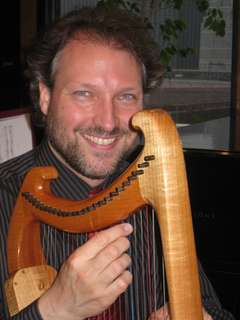|
Back
Night In The Garden of Spain New York
BargeMusic, Old Fulton Street, Brooklyn
06/05/2009 -
Martin Codax (fl. 1240 – 1270): Ondas do mare de Vigo – Mina yrmana fremosa
Alfonso X, El Sabio (1221 - 1284): Cantigar: Grand dereit
Las Huelgas Codex (13th Century): Salve Regina glorie
Llibre Vermell (Laste 14th Century): Virelai: Mariam Matreem Virginem – Ballada: Los set goyts recomptarem
From 14th Century Barcelona Mass: Kyrie – Sacro sanctus pater/Sanctus miro gaudio/Sanctus
Trebor (1380): Helas pitie
Faenza Codex (1400): Elas mon cuer (I)
Jacquemin de Senleches (1382): Fuions de ci – En attendant esperance – La Harpe de Melodie
Johannes Cuvelier (1372): Se Galaas
Trefoil: Drew Minter (Countertenor, harp and percussion), Mark Rimple (Countertenor, lute and harp), Marcia Young (Soprano and harp) 
Lutenist Mark Rimple (© Harry Rolnick)
The three soloists of “Trefoil” are in constant international demand, as specialists in pre-Renaissance polyphonic music. But when performing together, as they did for the beginning of the BargeMusic summer season, their expertise fused into worlds far away in time and space. To this musical mystery tour, Trefoil generated wonders lit with flambeaux the very Dark Ages.
Frankly, I had expected something a bit different. Ten days ago, I was sitting outside at a coffee house in Rabat, the capital of Morocco, listening to a wandering cithara player. Like so much else in urban Morocco, the music breathed was equally Andalusian and Arabic, and it was these mesmerizing tones which I was anticipating with Trefoil.
I couldn’t have been more in error. Moroccan music came from one section of Spain and had long been mixed with Berber, Hebrew and even influences from the one-time slaves from Mauritania and Sudan. Trefoil played the music as it had seemingly been composed in the 13th and 14th centuries, even before the forced exodus of the Semitic groups back to North Africa.
I say seemingly, for I had never heard the three-part harmony of the opening Mina yrmana fremosa. That sounded like later editing. But these were rare doubts for some very rare performances.
For the record, Marcia Young (a well-known voice on late-night Public Radio) played several harps, softly, almost as background. Her voice is most unusual, being always hushed, almost never with vibrato, the lips almost closed. In her lovely solo by Jacquemin de Senleches, sher never raised her voice, and the words were in a 13th Century language, yet one felt drawn to its almost naïve simplicity.
Drew Minter was billed as playing harp “and percussion”, though not a tambourine or snare was to be found. Instead, Mr. Minter played several harps of different string length, and, like Ms. Young, had a voice which, while technically precise, had a guileless tone. (One thinks of Fred Astaire, untrained yet musically infallible.)
The third of Trefoil was Mark Rimple, also playing several small and large harps, as well as the lute, an instrument which came from North Africa to Spain, and back again. This was not the complex lute music of Elizabethan times, but again a simpler accompanying instrument. Like Mr. Minter, he was a countertenor, though his voice was usually hushed, though he could give way to enough emotional outbursts at times.
The results of these combinations were usually surprising (though, without looking at the words in the program, a bit repetitive.) The melodies were misleadingly as simple as the voices. But if the range was limited, these same songs had the most subtle counterpoint with the instruments. Like Moroccan music of today, the melody and instruments seemed to have a tenuous relationship, one floating away while the other played on, then the different lines coming together at the right time.
The group were informal in their commentary, but increasingly, one saw that the Spanish music of this time was, if alien to non-experts, highly sophisticated. We had not yet reached the songs of the past 400 years, consisting of voice and sounds below. To West African or Indian musicians, our music can seem almost primitive. This ancient music, though, could be more interesting in form. Emotionally, with the strange harmonies and arcane language, one was drawn into the ceremonial, aristocratic and liturgical aura of another era.
The group also induced unforeseen bonuses. When singing from the Barcelona Mass, I had not fathomed why the 20th Century atonalist Anton Webern had taken such interest in early music. Here, though, where every hemidemisemiquaver and every fractional rest was counterpointed with every other note, singly yet part of the puzzle, it was evident how Webern worked his equally spiritual puzzles.
With the two countertenors and one soprano singing together, I was reminded of how Bach—both in the 4th Brandenburg with flutes and violin, and in the soprano choral section of the Magnificat—showed such delicacy of timbre for the treble voice.
The third bonus was that Divine Mystery of the so-called Dark Ages will forever remain a mystery. Yet, with resonances of Morocco still in my ears, how this enigmatic intermixing of Andalusian, Arab, Hebraic and yes, even rare Spanish Berber, was able to coalesce and evolve into the music of North Africa and later the guitar music which we know today.
True, the music of Trefoil had more verisimilitude with the original Christian and Greek modes than the “reproductions” of the Renaissance some three hundred years later. Most important, these singers, with their modesty of voice and seemingly modest instrumental technique, could transform this rocking, rolling barge under the Brooklyn Bridge into something approaching a faraway musical universe.
Harry Rolnick
|